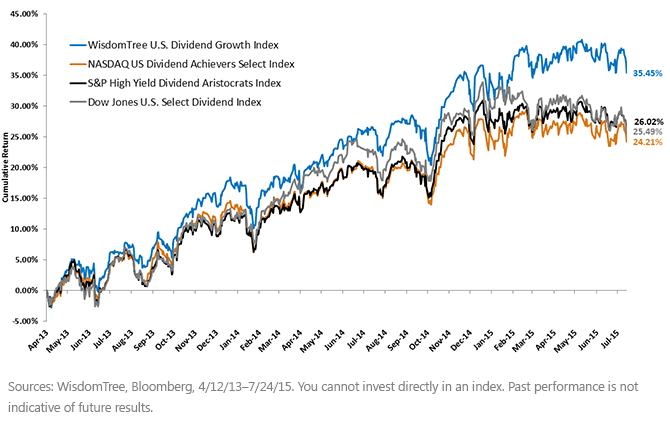Is Your Dividend Index Prepared for the Future?


 For definitions of indexes in the chart, visit our glossary.
• Information Technology: WTDGI’s forward-looking methodology and quality bias have resulted in the Index being over-weight the Information Technology sector compared to indexes reliant on backward dividend growth trends. This over-weight has added to the relative performance since inception, which makes sense to us because the sector is also one of the dividend growth leaders. Take Apple, for example, which is now the second-largest dividend payer in the United States, after only reinstating its dividend back in 2012. Since that time, Apple has grown its dividend by 37% on a cumulative basis,3 or more than 11% on an average annual basis. And using a backward-looking dividend growth methodology may exclude Apple for many years to come. Among the backward-looking indexes, the NASDAQ US Dividend Achievers has the largest weight to the Information Technology sector, but it was still a noticeable under-weight allocation to WTDGI over the period.
• Utilities: WTDGI’s focus on quality companies with low leverage and high future earnings growth has resulted in the Index being under-weight the Utilities sector compared to indexes reliant on backward dividend growth trends. This under-weight has added to the relative performance since inception, which makes sense to us because the sector typically offers low growth and tends to be highly rate sensitive as a result of its leverage. Year-to-date, the Utilities sector is one of the worst performing sectors, which we think is reflective of market participants positioning themselves in front of the Federal Reserve's rate hike by selling this rate-sensitive sector. As interest rates increase, these companies’ debt burdens will also increase, lowering the chances of potential dividend increases because cash flows have to be diverted to make higher coupon payments. Of the Indexes displayed above, the Dow Jones U.S. Select Dividend Index had the largest exposure to the Utilities sector, which represented nearly one-third of its Index. WTDGI, on the other hand, had less than one quarter of 1% exposure to the sector.4
Preparing for the Future
We believe that backward-looking indexes can keep the companies growing their dividends the fastest out of a portfolio. In fact, dividend indexes that employ backward-looking growth screens may not be able to take advantage of the technology firms and other companies driving today’s dividend growth trends for years to come. While no approach can predict which firms will increase their future dividends, we believe that being broad, flexible and forward-looking will enable WTDGI to more quickly respond to—and better capitalize on—the changing U.S. dividend landscape. In turn, we believe this methodology will track the performance of the companies growing their dividends the fastest today—and tomorrow.
1Refers to the Dow Jones U.S. Select Dividend Index, the NASDAQ US Dividend Achievers Select Index and the S&P High Yield Dividend Aristocrats Index, which have historical dividend growth requirements of five, 10 and 20 years, respectively, before constituents are eligible for index inclusion.
2Source: Bloomberg, 7/24/15.
3Sources: WisdomTree, Bloomberg, 7/24/12–7/24/15. As of 7/24/15, Apple had a 4.41% weight in the WisdomTree U.S. Dividend Growth Index.
4Sources: WisdomTree, Bloomberg, 7/24/15.
For definitions of indexes in the chart, visit our glossary.
• Information Technology: WTDGI’s forward-looking methodology and quality bias have resulted in the Index being over-weight the Information Technology sector compared to indexes reliant on backward dividend growth trends. This over-weight has added to the relative performance since inception, which makes sense to us because the sector is also one of the dividend growth leaders. Take Apple, for example, which is now the second-largest dividend payer in the United States, after only reinstating its dividend back in 2012. Since that time, Apple has grown its dividend by 37% on a cumulative basis,3 or more than 11% on an average annual basis. And using a backward-looking dividend growth methodology may exclude Apple for many years to come. Among the backward-looking indexes, the NASDAQ US Dividend Achievers has the largest weight to the Information Technology sector, but it was still a noticeable under-weight allocation to WTDGI over the period.
• Utilities: WTDGI’s focus on quality companies with low leverage and high future earnings growth has resulted in the Index being under-weight the Utilities sector compared to indexes reliant on backward dividend growth trends. This under-weight has added to the relative performance since inception, which makes sense to us because the sector typically offers low growth and tends to be highly rate sensitive as a result of its leverage. Year-to-date, the Utilities sector is one of the worst performing sectors, which we think is reflective of market participants positioning themselves in front of the Federal Reserve's rate hike by selling this rate-sensitive sector. As interest rates increase, these companies’ debt burdens will also increase, lowering the chances of potential dividend increases because cash flows have to be diverted to make higher coupon payments. Of the Indexes displayed above, the Dow Jones U.S. Select Dividend Index had the largest exposure to the Utilities sector, which represented nearly one-third of its Index. WTDGI, on the other hand, had less than one quarter of 1% exposure to the sector.4
Preparing for the Future
We believe that backward-looking indexes can keep the companies growing their dividends the fastest out of a portfolio. In fact, dividend indexes that employ backward-looking growth screens may not be able to take advantage of the technology firms and other companies driving today’s dividend growth trends for years to come. While no approach can predict which firms will increase their future dividends, we believe that being broad, flexible and forward-looking will enable WTDGI to more quickly respond to—and better capitalize on—the changing U.S. dividend landscape. In turn, we believe this methodology will track the performance of the companies growing their dividends the fastest today—and tomorrow.
1Refers to the Dow Jones U.S. Select Dividend Index, the NASDAQ US Dividend Achievers Select Index and the S&P High Yield Dividend Aristocrats Index, which have historical dividend growth requirements of five, 10 and 20 years, respectively, before constituents are eligible for index inclusion.
2Source: Bloomberg, 7/24/15.
3Sources: WisdomTree, Bloomberg, 7/24/12–7/24/15. As of 7/24/15, Apple had a 4.41% weight in the WisdomTree U.S. Dividend Growth Index.
4Sources: WisdomTree, Bloomberg, 7/24/15.Important Risks Related to this Article
Dividends are not guaranteed, and a company’s future ability to pay dividends may be limited. A company currently paying dividends may cease paying dividends at any time. Investments focusing on certain sectors and/or smaller companies increase their vulnerability to any single economic or regulatory development. This may result in greater share price volatility.


